
by Rick O'Connor | Sep 15, 2025
Introduction
The bay scallop (Argopecten irradians) was once common in the lower portions of the Pensacola Bay system. However, by 1970 they were all but gone. Closely associated with seagrass, especially turtle grass (Thalassia testudinum), some suggested the decline was connected to the decline of seagrass beds in this part of the bay. Decline in water quality and overharvesting by humans may have also been a contributor. It was most likely a combination of these factors.
Scalloping is a popular activity in our state. It can be done with a simple mask and snorkel, in relatively shallow water, and is very family friendly. The decline witnessed in the lower Pensacola Bay system was witnessed in other estuaries along Florida’s Gulf coast. Today commercial harvest is banned, and recreational harvest is restricted to specific months and to the Big Bend region of the state. With the improvements in water quality and natural seagrass restoration, it is hoped that the bay scallop may return to lower Pensacola Bay.
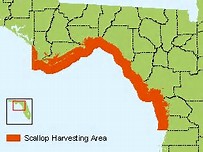
Scallop harvest area.
Image: Florida Department of Environmental Protection
Since 2015 Florida Sea Grant has held the annual Pensacola Bay Scallop Search. Trained volunteers survey pre-determined grids within Big Lagoon and Santa Rosa Sound. Below is the report for both the 2025 survey and the overall results since 2015.
Methods
Scallop searchers are volunteers trained by Florida Sea Grant. Teams are made up of at least three members. Two snorkel while one is the data recorder. More than three can be on a team. Some pre-determined grids require a boat to access, others can be reached by paddle craft or on foot.
Once on site the volunteers extend a 50-meter transect line that is weighted on each end. Also attached is a white buoy to mark the end of the line. The two snorkelers survey the length of the transect, one on each side, using a 1-meter PVC pipe to determine where the area of the transect ends. This transect thus covers 100m2. The surveyors record the number of live scallops they find within this area, measure the height of the first five found in millimeters using a small caliper, which species of seagrass are within the transect, the percent coverage of the seagrass, whether macroalgae are present or not, and any other notes of interest – such as the presence of scallop shells or scallop predators (such as conchs and blue crabs). Three more transects are conducted within the grid before returning.
The Pensacola Scallop Search occurs during the month of July.
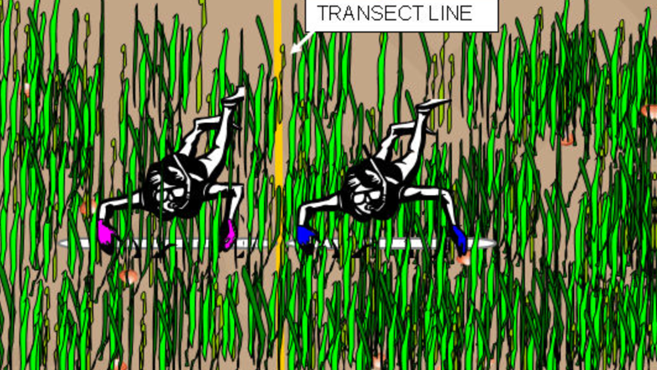
Snorkel transect method.
Image: University of Florida.
2025 Results
138 volunteers on 32 teams surveyed 22 of the 66 1-nautical mile grids (36%) between Big Lagoon State Park and Navarre Beach. 162 transects (16,200m2) were surveyed logging 8 scallops. All live scallops were reported from Santa Rosa Sound this year.
2025 Big Lagoon Results
13 teams surveyed 9 of the 11 grids (81%) within Big Lagoon. 76 transects were conducted covering 7,600m2.

No scallops were logged in 2025 though scallop shells were found. No sea urchins were reported but scallop predators – such as conchs, blue crabs, and rays were. This equates to 0.00 scallops/200m2 and moves Big Lagoon from a vulnerable system last year to a collapsed one this year. All three species of seagrass were found (Thalassia, Halodule, and Syringodium). Seagrass densities ranged from 50-100%. Macroalgae was present in 5 of the 9 grids (56%) and was reported abundant in grid 2.
2025 Santa Rosa Sound Results
19 teams surveyed 13 of the 55 grids (23%) in Santa Rosa Sound. 86 transects were conducted, covering 8,600m2.
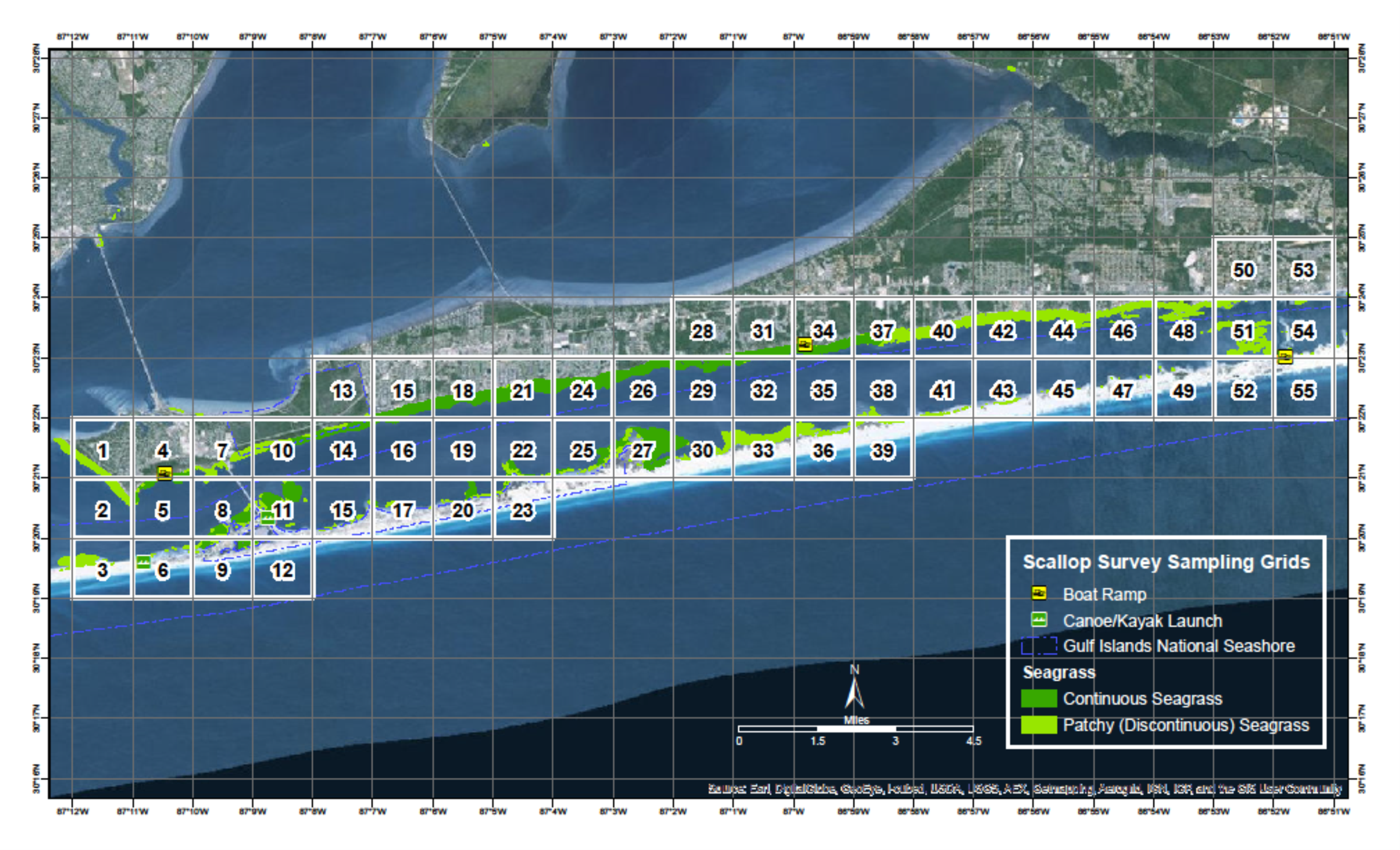
8 scallops were logged which equates to 0.19 scallops/200m2. Scallop searchers reported blue crabs, conchs, and rays. All three species of seagrass were found. Seagrass densities ranged from 5-100%. Macroalgae was present in 7 of the 13 grids (54%) and was reported as abundant in 4 of those.
2015 – 2025 Big Lagoon Results
| Year |
No. of Transects |
No. of Scallops |
Scallops/200m2 |
| 2015 |
33 |
0 |
0.00 |
| 2016 |
47 |
0 |
0.00 |
| 2017 |
16 |
0 |
0.00 |
| 2018 |
28 |
0 |
0.00 |
| 2019 |
17 |
0 |
0.00 |
| 2020 |
16 |
1 |
0.12 |
| 2021 |
18 |
0 |
0.00 |
| 2022 |
38 |
0 |
0.00 |
| 2023 |
43 |
2 |
0.09 |
| 2024 |
67 |
101 |
3.02 |
| 2025 |
76 |
0 |
0.00 |
| Big Lagoon Overall |
399 |
104 |
0.52 |
2015 – 2025 Santa Rosa Sound Results
| Year |
No. of Transects |
No. of Scallops |
Scallops/200m2 |
| 2015 |
01 |
0 |
0.00 |
| 2016 |
01 |
0 |
0.00 |
| 2017 |
01 |
0 |
0.00 |
| 2018 |
01 |
0 |
0.00 |
| 2019 |
01 |
0 |
0.00 |
| 2020 |
01 |
0 |
0.00 |
| 2021 |
20 |
0 |
0.00 |
| 2022 |
40 |
2 |
0.11 |
| 2023 |
28 |
2 |
0.14 |
| 2024 |
85 |
32 |
0.76 |
| 2025 |
86 |
8 |
0.19 |
| Santa Rosa Sound Overall |
2591 |
44 |
0.34 |
1 Transects were conducted during these years but data for Santa Rosa Sound was logged by an intern with the Santa Rosa County Extension Office and is currently unavailable.
Discussion
Based on a Florida Fish and Wildlife Research Institute publication in 2018, the final criteria are used to classify scallop populations in Florida.
| Scallop Population / 200m2 |
Classification |
| 0-2 |
Collapsed |
| 2-20 |
Vulnerable |
| 20-200 |
Stable |
Based on this, over the last nine years we have surveyed, the populations in lower Pensacola Bay are still collapsed. Big Lagoon reached the vulnerable level in 2024, but no scallops were found there in 2025, returning to a collapsed state.
There are some possible explanations for low numbers in 2025.
- It has been reported by some shellfish biologists that bay scallops have a “boom-bust” cycle. Meaning that one year their populations “boom” before returning to normal numbers. We could have witnessed this between 2024 and 2025.
- Though we did not monitor water temperatures, July 2025 was extremely hot, and many volunteers reported their sites felt like “bath water”. Collecting efforts on other projects during July reported not capturing anything – no pinfish, hermit crabs – their nets were empty. It is possible that these warm conditions could have caused many organisms to move to deeper/cooler depths. Note here; as the project moved into August temperatures did begin to cool and searchers began reporting fish, conchs, blue crabs, and rays.
The Pensacola Bay area continues to have a collapsed system. The larger populations found in 2024 suggest that there are scallops in the area but may not be enough to increase their population status from collapsed to vulnerable. We will continue to monitor each July.
It is important for locals NOT to harvest scallops from either body of water. First, it is illegal. Second, any chance of recovering this lost population will be lost if the adult population densities are not high enough for reproductive success.
Acknowledgements
We would like to thank ALL 138 volunteers who surveyed this year. We obviously could not have done this without you.
Below are the “team captains”.
Ethan Sadowski John Imhof Kaden Luttermoser
John Wooten Susan Pinard Matt MacGregor
Christian Wagley Sean Hickey Jason Buck
Brian Mitchell Angela Guttman Caitlen Murrell
Samantha Brady (USM) Michelle Noa Kira Benton
Monica Hines Wesley Allen Kelly Krueger
Mikala Drees Jonathan Borowski Michael Currey
Gina Hertz Melinda Thoms Beau Vignes
Bill Garner Robert Moreland Stephanie Kissoon
Nick Roest Leah Yelverton

A team of scallop searchers celebrates after finding a few scallops in Pensacola Bay.

Volunteer measures a scallop he found.
Photo: Abby Nonnenmacher
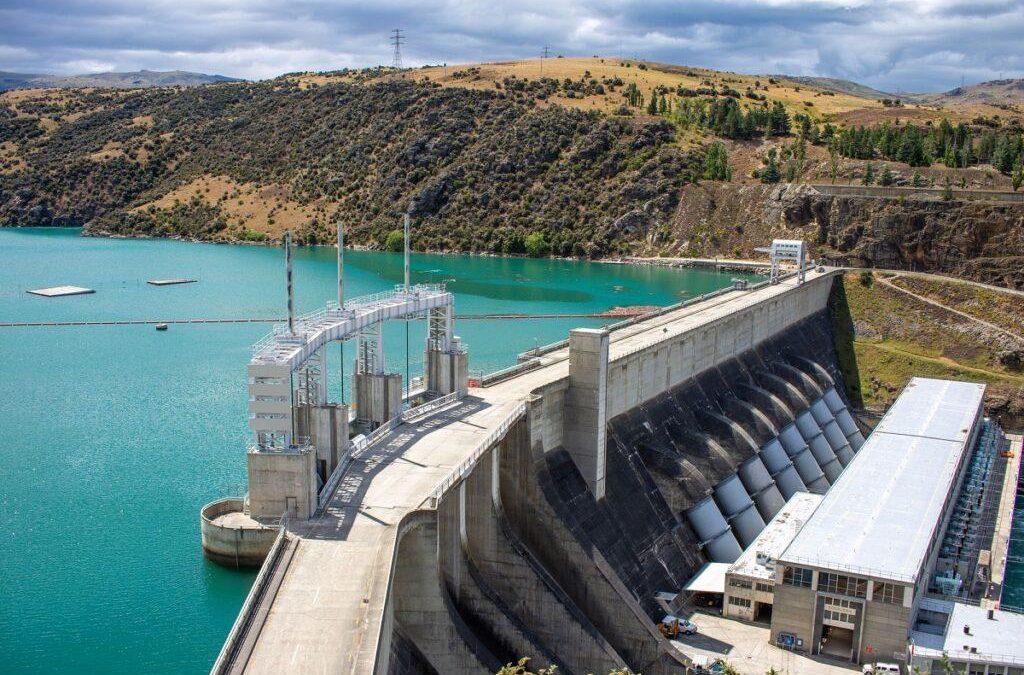
by Rick O'Connor | Sep 15, 2025
This form of renewable energy has been used for decades. Water at higher elevations flows towards the sea. Placing a hydroelectric dam on such a waterway the flowing water can turn the turbines and generate electricity. It is the number one source of renewable energy around the world, and – when including environmental costs – one of the least expensive way to generate electricity.
In 2011 much of the world was looking towards increasing hydroelectric power. Today it is the number one form of renewable energy around the world and growth is predicted to remain stable through 2030. One issue of hydropower is droughts generated by climate change. The are other concerns as well – such as the production of methane from anaerobic decomposition from submerged plants on the bottom of the reservoirs, and the build up of silt within the turbines coming from the rivers flowing through them.
| Advantages |
Disadvantages |
| Moderate to high net energy |
High construction costs |
| High efficiency (80%) |
High environmental impact from flooding due to the reservoir |
| Low-cost electricity |
High CO2 emissions from rapid biomass decay in shallow tropical reservoirs |
| Long life span |
Danger of collapse |
| No CO2 emissions during operation in temperate areas |
Uproots people |
| Provides irrigation water |
Decreases fish harvest below dam |
| Reservoir useful for recreation |
Decreases need silt below dam |
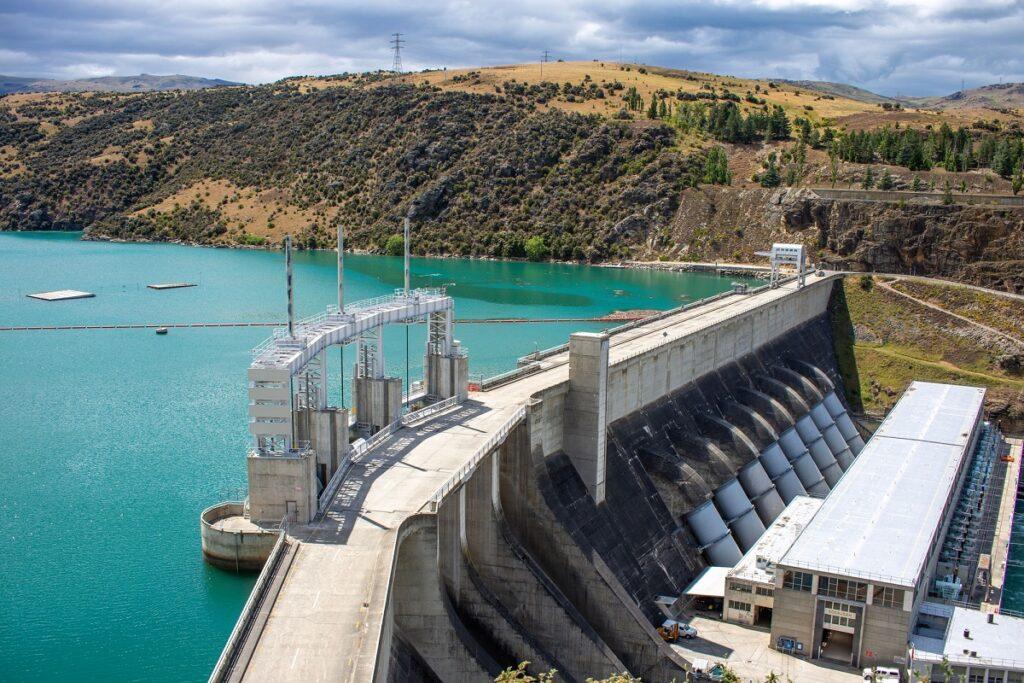
Hydroelectric power has its pros and cons.
Photo: Energytheory.
References
Projected Costs of Generating Electricity by 2020. International Energy Agency. https://www.iea.org/reports/projected-costs-of-generating-electricity-2020.
Hydroelectricity. International Energy Agency. https://www.iea.org/energy-system/renewables/hydroelectricity.
Miller, G.T., Spoolman, S.E. 2011. Living in the Environment. Brooks/Cole Cengage Learning. Belmont CA. pp. 674.

by Rick O'Connor | Sep 8, 2025
They continue to come. Invasive species have always been a problem in Florida and many of the south Florida species are moving north. One of these is a new marine snail – the thrush cowrie.
This snail is from the Red Sea and Indian Ocean and has been dispersing across the oceans for some time now. Their larva are planktonic and can be carried by the current but are also believed to be dispersed via ships ballast. They were first reported along the eastern coast of Florida in 2022 and have recently been found along the Florida panhandle.
They are most abundant in waters less than 25’ feeding on vegetation but secrete their eggs on hard substrate like jetties and seawalls. If you find this snail, please remove it from the water and report it to your Sea Grant Agent at the local Extension Office. Information we would like when reporting includes the date found, time, location (latitude and longitude if known), water depth, how many, live or dead, your name, and any comments you would like to include.

The thrush cowrie.
Photo: FWC.

by Rick O'Connor | Sep 8, 2025
We will begin our look at solar energy by explaining there are two forms – passive and active. In passive solar energy the well insulated building is heated directly from the sun without the need for additional technologies. In active solar energy the build has solar panels. These panels have a heat-absorbing fluid which collects solar energy and can use it directly within the house or store it for later use. Here are some advantages and disadvantages of passive or solar heating.
| Advantages |
Disadvantages |
| Energy is free |
Need access to the sun 60% of the time |
| Quick installation |
Sun can be blocked by trees and other structures |
| No CO2 emissions |
Need a heat storage system |
| Very low air and water pollution |
High cost |
| Very low land disturbance |
Active systems need maintenance and repairs |
|
Active collectors can be unattractive |
Another problem is that most solar energy designs are designed to heat the buildings, not cool – but there are technologies that can help with this – such as:
- Block summer sun with window overhangs and awnings.
- Use a light-colored roof to reflect as much as 80% of the sun’s heat.
- Suspend reflective insulating foil in the attic to block heat from radiating into the house.
- Place plastic earth tubes into the ground where the earth is cool year-round. Tiny fans can pipe cool air into the house when needed.
- Use geothermal heat pumps.
Can solar energy be used for high-temperature heat demands – such heating water and generating steam for electricity?
It can, but there are trade-offs.
| Advantages |
Disadvantages |
| Moderate net energy |
Low efficiency |
| Moderate environmental impact |
High costs |
| No CO2 emissions |
Needs back up and storage systems |
| Fast construction (1-2 years) |
Needs access to the sun most of the time |
|
Vulnerable to sabotage |
|
Land use that could be used for other resources |
Solar cells can be used to produce electricity directly. This electricity can be used directly within the building or stored for later use. This electricity can be connected to the grid and some countries require power companies to purchase excess electricity produced by homes placed on the grid. These solar cells have no moving parts, are safe and quiet, require little maintenance, produce no pollution, and last as long as conventional fossil fuel and nuclear energy sources. There are some issues…
| Advantages |
Disadvantages |
| Fairly high net energy yield |
Need access to the sun |
| They work on cloudy days |
Need storage and back up systems |
| Quick installation |
High costs |
| Easily expanded or moved |
High land use |
| No CO2 emissions |
DC current must be converted to AC |
| Low environmental impact |
|
| Last 20-40 years |
|
As many already know, Florida Power and Light has already invested in this technology – as has the U.S. military. In our next article we will look at producing electricity from the water cycle.
References
Miller, G.T., Spoolman, S.E. 2011. Living in the Environment. Brooks/Cole Cengage Learning. Belmont CA. pp. 674.

by Rick O'Connor | Aug 25, 2025
Over the last couple of articles, we have seen how humans moved from a wood-based energy source to coal and from coal to oil. With the onset of the industrial revolution, new innovations such as electricity and transportation, our energy needs have increased – along with our population.
In Part 16 we looked at the advantages and disadvantages of continuing using fossil fuels for our energy needs. We also looked at nuclear energy. Many feel that these pros and cons are sufficient enough to continue with fossil fuels – for now. Others, including some energy companies, believe it is time to look for other alternatives. It is estimated that fossil fuels will last another 200-500 years, and as we get closer to those deadlines, prices will go up. And then there is the concern surrounding the environmental impacts of burning fossil fuels. Enter the renewables.
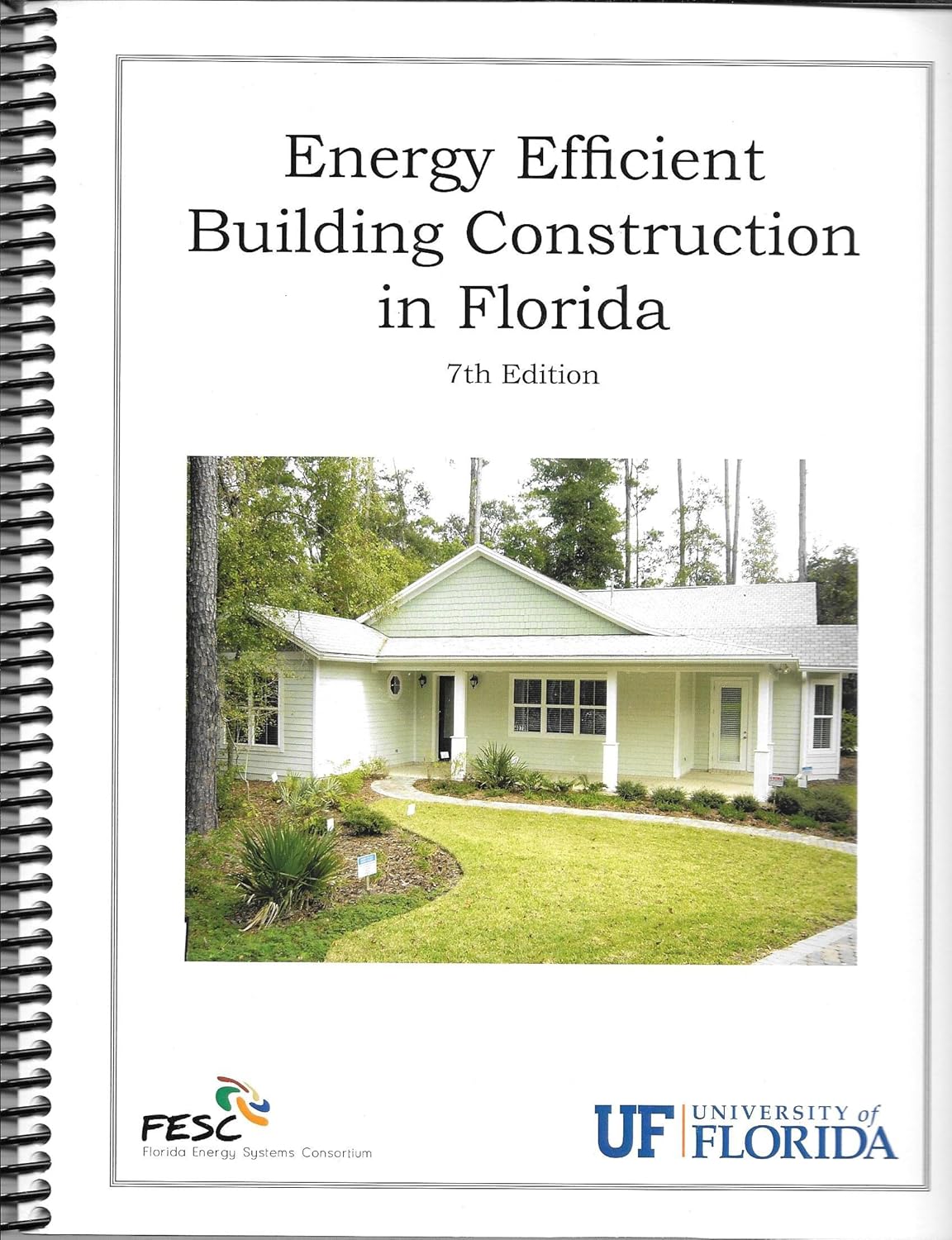
We can begin by making our homes, businesses, and vehicles more energy efficient.
Photo: UF IFAS
Miller and Spoolman1 begin their chapter on this topic but discussing energy efficiency – the idea of using our current energy sources more wisely and, possibly, extending the deadline. Many of us already use energy efficient appliances, energy efficient building designs, and energy efficient cars. Some of this is forced on us. Some are to help us reduce our energy costs. But this movement has already begun. Data from the U.S. Department of Energy in 2011 stated that fossil fuels accounted for 85% of our energy input. 84% of that energy became unavoidable energy waste (41%) and unnecessary energy waste (43%). Only 9% were converted into useful energy. The incandescent light bulb uses only 5-10% of its energy to produce light, the rest is lost as heat. 94% of the energy in the internal combustion engine is lost as heat. Only 34% of the energy used to burn coal actually becomes electricity.
In 2011 industry accounted for 30% of the worlds, and 38% of the U.S., energy consumption. Miller and Spoolman provide methods in which industry can become more energy efficient.
- Replace energy-wasting electric motors.
- Recycle materials like steel and other metals.
- Switch from low-efficient incandescent to fluorescent or LED lighting.
Many industries have already made such changes.
In 2011, transportation accounted for 67% of the oil consumption in the U.S. During the 1970s the federal government began requiring fuel efficient cars and trucks. Fuel efficiency increased until about 1985 were it peaked – it has remained at this level since. Though vehicles are more fuel efficient than they were in the 1960s, U.S. consumers still prefer large trucks and SUVs to more fuel-efficient vehicles. There has been recent interest in electric vehicles. But recent reports suggest some automakers may be reducing their inventory of such cars and trucks.
There is a whole new industry in energy efficient buildings – “green buildings”. Most of our buildings were not designed with energy efficiency in mind. For those there are some things we can do to improve energy efficiency.
- Insulate and plug leaks. Over 30% of American homes lose their heated air through holes, cracks, and single paned windows.
- Energy efficient windows. This can reduce heat/AC loss by over 50%.
- Use more energy efficient appliances.
- Use more energy efficient lighting.
Other suggestions within the home include;
- The attic. Hang reflective foil to reflect heat. Use a house fan. Be sure attic insulation is at least 12 inches thick.
- Install water saving toilets, faucets, and shower heads. Repair water leaks.
- Use microwave as much as possible. Run only full loads in the dishwater and use low – or no-heat – drying. Clean refrigerator coils regularly.
- Other rooms. Use compact fluorescent lighting and LED lighting. Turn off lights, TV, computers when not in use. Set the thermostat as low as possible in the winter, and as high as possible in the summer. Weather strip and caulk doors and windows. Use fans.
- Plant trees to shade/cool house.
In our next article we will begin looking at new forms of energy that could replace fossil fuels.
References
Miller, G.T., Spoolman, S.E. 2011. Living in the Environment. Brooks/Cole Cengage Learning. Belmont CA. pp. 674.













